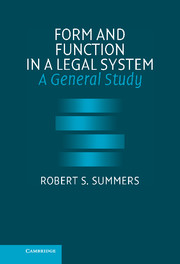Book contents
- Frontmatter
- Contents
- Preface
- Acknowledgments
- PART ONE INTRODUCTION, BASIC CONCEPTS AND DEFINITIONS, AND A GENERAL APPROACH
- PART TWO THE FORMS OF FUNCTIONAL LEGAL UNITS
- 4 Forms of Institutions – Legislative
- 5 Forms of Precepts – Rules
- 6 Form and Content within a Rule – Continued
- 7 Forms of Nonpreceptual Law – Contracts and Related Property Interests
- 8 Forms of Legal Methodologies – Statutory Interpretation
- 9 Forms of Sanctions and Remedies
- PART THREE THE OVERALL FORM OF A LEGAL SYSTEM AND ITS OPERATION
- Name Index
- Subject Index
6 - Form and Content within a Rule – Continued
Published online by Cambridge University Press: 29 July 2009
- Frontmatter
- Contents
- Preface
- Acknowledgments
- PART ONE INTRODUCTION, BASIC CONCEPTS AND DEFINITIONS, AND A GENERAL APPROACH
- PART TWO THE FORMS OF FUNCTIONAL LEGAL UNITS
- 4 Forms of Institutions – Legislative
- 5 Forms of Precepts – Rules
- 6 Form and Content within a Rule – Continued
- 7 Forms of Nonpreceptual Law – Contracts and Related Property Interests
- 8 Forms of Legal Methodologies – Statutory Interpretation
- 9 Forms of Sanctions and Remedies
- PART THREE THE OVERALL FORM OF A LEGAL SYSTEM AND ITS OPERATION
- Name Index
- Subject Index
Summary
“[A] body of law is more rational and more civilized when every rule it contains is referred articulately and definitely to an end which it subserves, and when the grounds for desiring that end are stated… .”
– O. W. Holmes, Jr.“[I]rrationality of form continually breeds irrationality of substance …”
– R. PoundINTRODUCTION
In this chapter I continue to concentrate on one type of preceptual form – the overall form of a legal rule – that workhorse precept in all developed systems. First, the purposes of rules and of their overall form are summarized. We then analyze more fully how choices of features within this form contribute to the creation of a rule, and how in the course of this, two-way interactions occur between such choices and choices of policy or other complementary content. Form leaves its imprints and other effects on content, and content in turn shapes form. These interactions, which are set forth throughout in the idiom of choices, are analyzed to advance understanding of the attributes of legal rules, including their makeup, unity, instrumental capacity, and distinctive identity. This will also lay bare more fully the credit due to choices of form in rules for the realization of ends and values.
The role of rationality in the construction of rules will be addressed throughout. Given the founding purpose of creating the functional unit of a legal rule, reason obviously requires adoption of the overall form of a rule.
- Type
- Chapter
- Information
- Form and Function in a Legal SystemA General Study, pp. 182 - 210Publisher: Cambridge University PressPrint publication year: 2005



